All hyacinth flowers bloom on the site almost simultaneously and create a joyful, festive spring mood on the flower beds.
Material Content:
Description of species and varieties
Hyacinths are grown both in flower beds and at home. There are many varieties of these delightful flowers that gardeners enjoy cultivating throughout the country.
For outdoor cultivation
Today, only three main varieties of hyacinths are grown.
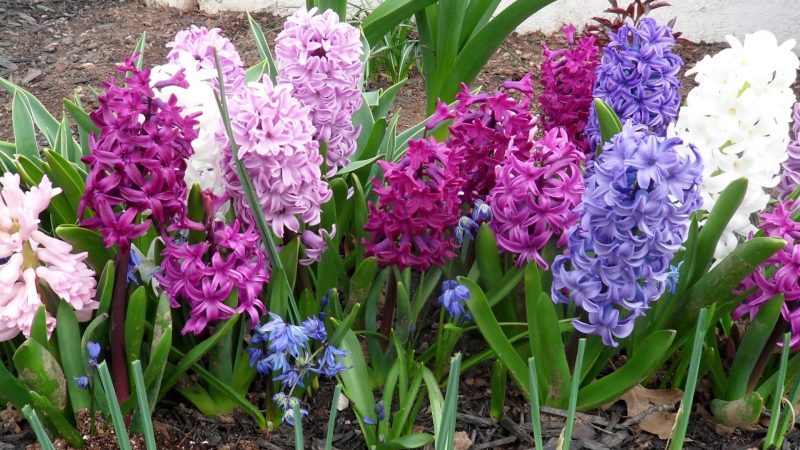
- In Asia, an oriental species is very common, which expels peduncles up to 30 cm. The species blooms with purple flowers.
- Hyacinth Litvinova is similar to the eastern one, but has a more spreading inflorescence. Blooms with blue flowers.
- Trans-Caspian hyacinth grows in Iran and reaches a height of only 20 cm.
Based on these three species, many varieties are bred.
- A very popular variety with purple-red inflorescence "Woodstock".
- Carnegie hyacinth has snow-white flowers.
- "Chicago" blooms in blue and white, he was bred in Holland.
- A very beautiful variety for open ground "Royal Navy", which is the color of bright blue flowers.
Indoor varieties
Although there are more than 400 varieties of hyacinths, not all of them are suitable for growing in a room.
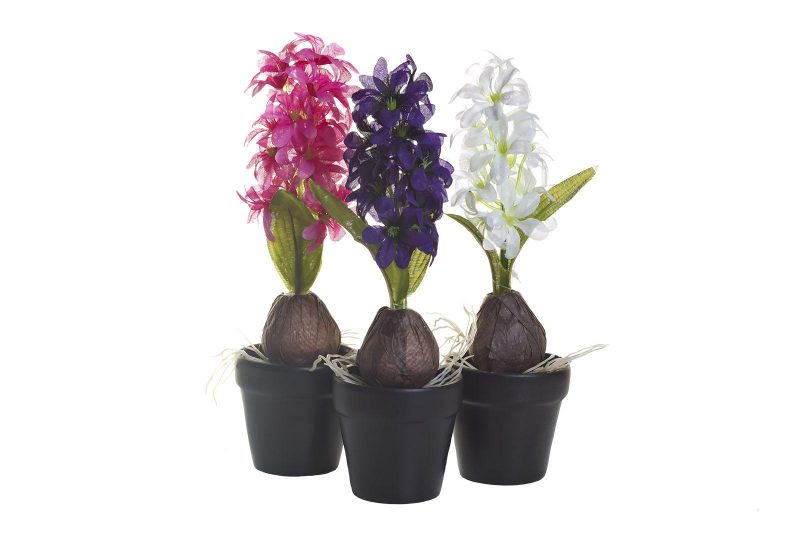
At home, the easiest way to grow oriental hyacinth, or rather some of its varieties. Varieties “La Victoire”, “Sunflower”, “Rosalia”, “Arenina Arendsen” are very popular among flower growers.
Also in the conditions of the apartment, the appearance of Litvinov and its varieties lends itself to distillation.
Planting hyacinths in open ground
Before you get these flowers in the front garden, you need to choose the best place for them. Hyacinths like high fertile soil, light soil. A wetland that is often flooded does not fit them. In excessively moist soil, the bulbs will rot.
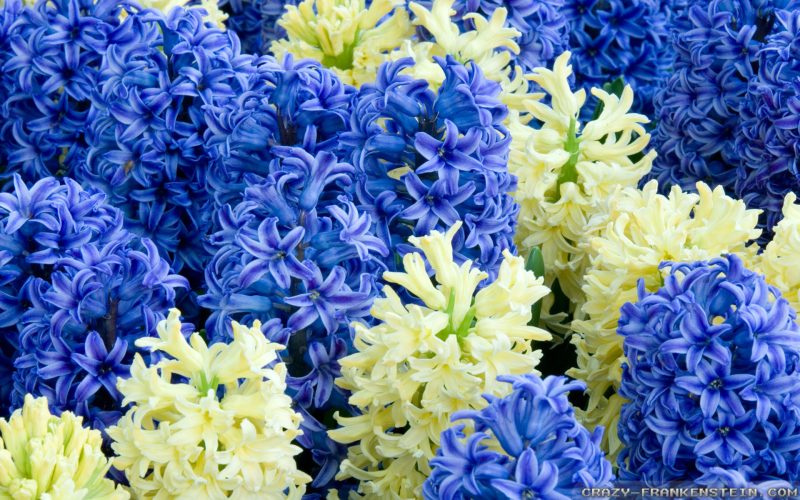
Plants love sunlit places protected from the north wind.
About a month before planting, the selected site is dug up to a depth of about 25 cm. When digging, 8 kg of humus is added to each square of the earth. If there is no humus, superphosphate can be embedded in the earth at the rate of 100 g per square. Under no circumstances should fresh manure or bird droppings be brought under hyacinths.
When possible, hyacinth planting is carried out in autumn. Bulbs are planted bottom-down, maintaining a distance between specimens of about 30 cm. They are planted to a depth two times the diameter of the corm.
When planting, you can make a sand cushion - about 3 cm thick sand is poured along the bottom of the hole. Bulbs are laid on it and sprinkled, as usual, with soil, which is immediately shed. If the bulb is planted on the sand, then there will be no bottom rot.
How to care for flowers in the garden
Care for hyacinth in the garden is necessary taking into account the time of year.

- Autumn. If it is arid, the planting should be regularly watered so that the plant has time to form the root system. About a week before the first frost, watering is completely stopped. When steady colds come, they mulch the landing. This can be done with various covering materials, which allow air to pass through well.
- Winter. If there will be little snow in the winter, you must ensure that the plantings are covered. If it is not at all, then it is recommended to cover the site with geotextiles
- Spring and summer. As soon as the snow melts in the spring, the mulch is carefully removed. They do this with extreme caution, because already in early spring the bulbs shoot, and they are very tender and vulnerable. In mid-spring, flowers begin to grow very quickly - now weeding and cultivation are needed.
To make hyacinths bloom magnificently, it is necessary to make top dressing.
- In the spring, when watering make nitrogen and potassium.
- When buds appear, hyacinths are fed with complex mineral supplements.
- When the flowers have completely faded, potassium and phosphorus are introduced into the ground. This will allow them to form strong bulbs and give children.
In dry periods, hyacinths must be watered. Moisture is especially needed at the time of budding. But you can not fill the flower too much, because due to excessive moisture the bulbs easily rot and disappear.
When to dig out and how to store hyacinth bulbs
A warm climate with mild winters allows hyacinths to winter directly in the ground. If in the southern regions you can leave hyacinths in the garden for wintering, then in the regions with a harsh climate, these flowers need to be dug up every autumn. The time when you should start digging the bulbs is the blackening of the leaves. At this point, they begin to prepare their heads for wintering and rest.
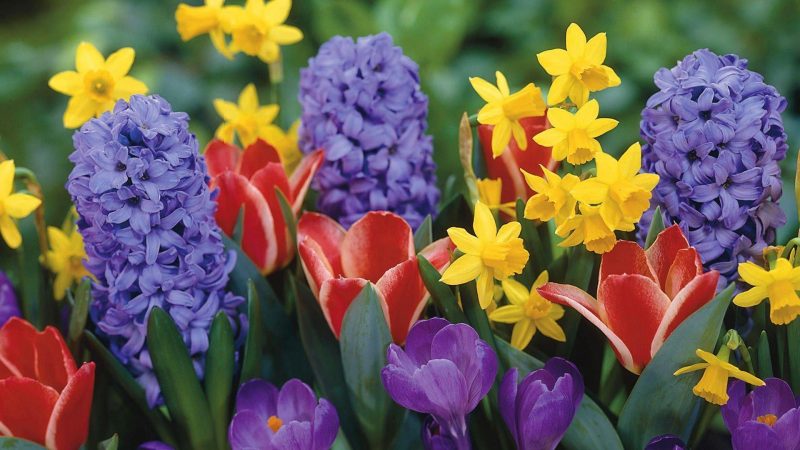
Usually they start digging in July:
- Bulbs are carefully dug up with a shovel or pitchfork and cleaned of soil.
- The foliage is cut and placed in blown boxes. So they should lie in the shade for several days until they dry out.
- The dried material is cleaned of unnecessary peels, freed from dried rhizomes. Now is the time to separate the children from large bulbs.
- All specimens are sorted and stacked in wooden containers.
The resting period of this flower lasts about three months. Of these, it is advisable to store the bulbs at +25 ºС for 60 days. Then the boxes are transferred to a room in which about +17 ºС. In such cool conditions, the material should lie for another 35 days. Bulbs are sprayed systematically so that they do not dry out too much.
Very often during storage, large bulbs form children that can be separated even in winter and planted in a flowerpot. Such plants will bloom only for 3 years.
Growing and caring at home
A home hyacinth flower needs an environment as close to the conditions of the garden as possible. The soil mix can be purchased in a gardening store, or you can make it yourself. To this end, compost, sod, still leafy soil and humus are mixed in equal proportions. Sand and a little peat should be added to the soil mixture.
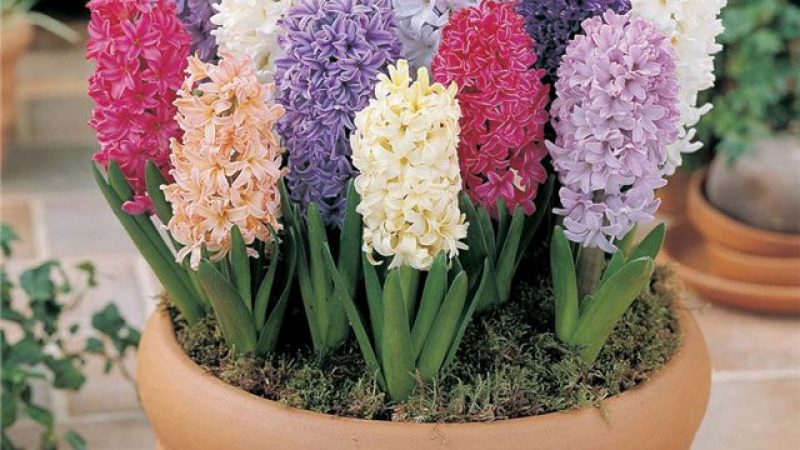
- For planting, first drainage is arranged at the bottom of the flowerpot. Expanded clay is excellent for this purpose.
- Then a small layer of soil mixture and a layer of sand are poured onto the drainage.
- Bulbs are laid out in the sand. You can plant several units in one pot so that they form a bouquet during flowering.
- Onions are carefully sprinkled with the remaining soil and spilled.
- Sprinkle the soil from above with sand.
Bulbs cannot be completely buried - the tops should be at the top.
Flowerpots should be kept in a dark place to provide the plants with a rest period. The optimum temperature is +10 ºС. Drying of coma should not be allowed.
Then the flowers arrange an artificial spring, for which they transfer the flowerpots into a warm and necessarily bright room. Optimum temperature +15 ºС. As soon as the hyacinths bloom, they are kept at +20 ºС.
- Flowers need frequent watering, good lighting and the application of complex fertilizing twice a month.
- The ground in the pot must be moist, but not too wet.
- The pot is constantly turned to the light source so that the hyacinth grows evenly.
- On cloudy days, flowers light up.
Plant propagation methods
Reproduction of these flowers by seeds is of interest only to experienced breeders. As a rule, such plants do not retain varietal traits. It is much simpler and much faster to propagate the flower vegetatively.

The root of the flower usually gives about two children. When digging bulbs, they are torn off, dried and planted already in the fall in the flower garden. In two to three years, the children will bloom.
At home, you can propagate the flower by cutting the bottom. This is a fairly painstaking method in which all the bottom is completely cut off. As a result, the bulb gives a lot of children.
There is still a method of reproduction using incision of bulbs. At the same time, deep incisions are made at the bottom. As a result of such cross-shaped incisions, the bulb in the first season gives a lot of children.
Protection against diseases and pests
The biggest harm in the garden to hyacinths is caused by aphids and thrips. The leaves as a result of attacks of these insects begin to turn yellow, and the buds fall off. Handle flowers need pesticides. You can use "Akarin" or "Accord."

Of the diseases, hyacinths can infect rot. As a result, the bulbs themselves begin to rot and die. To prevent the disease, the soil is kept moderately moist, preventing its excessive wetting.
Hyacinths can also get bacterioses. Sick plants will have to be burned. Flowers can only be returned to their original place after 5 years.
The legend of hyacinth flower

In Greek, the name of the culture means "rainy flower." In mythology, a young man was called a hyacinth. Legend has it that he died in a contest, but a beautiful flower grew at the place of death. Since then, hyacinths have been a symbol of grief and rebirth.












